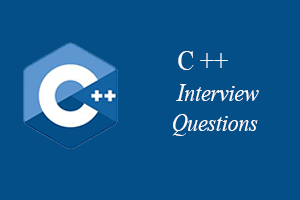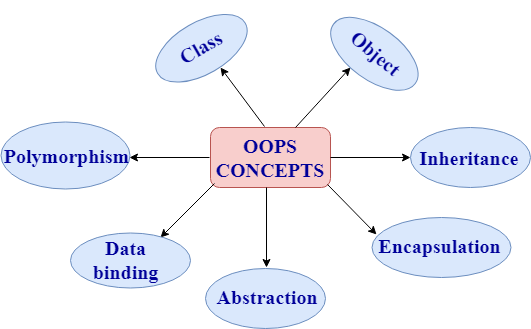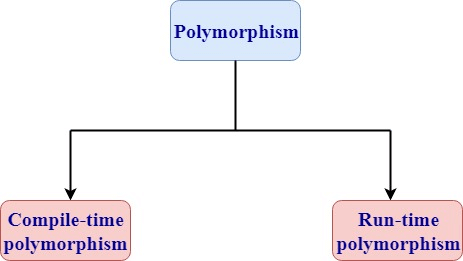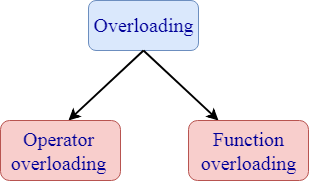Are you looking to Enroll in course?
Are you ready to take your skills to the next level? Enroll in our course today and unlock your full potential
Live Classes: Upskill your knowledge Now!
Chat NowPublished - Mon, 05 Dec 2022

A list of top frequently asked C++ interview questions and answers are given below.
C++ is an object-oriented programming language created by Bjarne Stroustrup. It was released in 1985.
C++ is a superset of C with the major addition of classes in C language.
Initially, Stroustrup called the new language "C with classes". However, after sometime the name was changed to C++. The idea of C++ comes from the C increment operator ++.
C++ doesn't only maintains all aspects from C language, it also simplifies memory management and adds several features like:
Following are the differences between C and C++:
| C | C++ |
|---|---|
| C language was developed by Dennis Ritchie. | C++ language was developed by Bjarne Stroustrup. |
| C is a structured programming language. | C++ supports both structural and object-oriented programming language. |
| C is a subset of C++. | C++ is a superset of C. |
| In C language, data and functions are the free entities. | In the C++ language, both data and functions are encapsulated together in the form of a project. |
| C does not support the data hiding. Therefore, the data can be used by the outside world. | C++ supports data hiding. Therefore, the data cannot be accessed by the outside world. |
| C supports neither function nor operator overloading. | C++ supports both function and operator overloading. |
| In C, the function cannot be implemented inside the structures. | In the C++, the function can be implemented inside the structures. |
| Reference variables are not supported in C language. | C++ supports the reference variables. |
| C language does not support the virtual and friend functions. | C++ supports both virtual and friend functions. |
| In C, scanf() and printf() are mainly used for input/output. | C++ mainly uses stream cin and cout to perform input and output operations. |
Following are the differences between reference and pointer:
| Reference | Pointer |
|---|---|
| Reference behaves like an alias for an existing variable, i.e., it is a temporary variable. | The pointer is a variable which stores the address of a variable. |
| Reference variable does not require any indirection operator to access the value. A reference variable can be used directly to access the value. | Pointer variable requires an indirection operator to access the value of a variable. |
| Once the reference variable is assigned, then it cannot be reassigned with different address values. | The pointer variable is an independent variable means that it can be reassigned to point to different objects. |
| A null value cannot be assigned to the reference variable. | A null value can be assigned to the reference variable. |
| It is necessary to initialize the variable at the time of declaration. | It is not necessary to initialize the variable at the time of declaration. |
The class is a user-defined data type. The class is declared with the keyword class. The class contains the data members, and member functions whose access is defined by the three modifiers are private, public and protected. The class defines the type definition of the category of things. It defines a datatype, but it does not define the data it just specifies the structure of data.
You can create N number of objects from a class.
The various OOPS concepts in C++ are:

The class is a user-defined data type which defines its properties and its functions. For example, Human being is a class. The body parts of a human being are its properties, and the actions performed by the body parts are known as functions. The class does not occupy any memory space. Therefore, we can say that the class is the only logical representation of the data.
The syntax of declaring the class:
An object is a run-time entity. An object is the instance of the class. An object can represent a person, place or any other item. An object can operate on both data members and member functions. The class does not occupy any memory space. When an object is created using a new keyword, then space is allocated for the variable in a heap, and the starting address is stored in the stack memory. When an object is created without a new keyword, then space is not allocated in the heap memory, and the object contains the null value in the stack.
The syntax for declaring the object:
Inheritance provides reusability. Reusability means that one can use the functionalities of the existing class. It eliminates the redundancy of code. Inheritance is a technique of deriving a new class from the old class. The old class is known as the base class, and the new class is known as derived class.
Syntax
Encapsulation is a technique of wrapping the data members and member functions in a single unit. It binds the data within a class, and no outside method can access the data. If the data member is private, then the member function can only access the data.
Abstraction is a technique of showing only essential details without representing the implementation details. If the members are defined with a public keyword, then the members are accessible outside also. If the members are defined with a private keyword, then the members are not accessible by the outside methods.
Data binding is a process of binding the application UI and business logic. Any change made in the business logic will reflect directly to the application UI.
Polymorphism means multiple forms. Polymorphism means having more than one function with the same name but with different functionalities. Polymorphism is of two types:
Polymorphism: Polymorphism means multiple forms. It means having more than one function with the same function name but with different functionalities.
Polymorphism is of two types:

Runtime polymorphism is also known as dynamic polymorphism. Function overriding is an example of runtime polymorphism. Function overriding means when the child class contains the method which is already present in the parent class. Hence, the child class overrides the method of the parent class. In case of function overriding, parent and child class both contains the same function with the different definition. The call to the function is determined at runtime is known as runtime polymorphism.
Let's understand this through an example:
Output:
javaTpoint tutorial
Compile-time polymorphism is also known as static polymorphism. The polymorphism which is implemented at the compile time is known as compile-time polymorphism. Method overloading is an example of compile-time polymorphism.
Method overloading: Method overloading is a technique which allows you to have more than one function with the same function name but with different functionality.
Method overloading can be possible on the following basis:
Let's understand this through an example:
Output:
6 24
Syntax of accessing the namespace variable:
Let's understand this through an example:
Output:
10
A token in C++ can be a keyword, identifier, literal, constant and symbol.
Bjarne Stroustrup.
Following are the operations that can be performed on pointers:
There are two types of increment pointers:
1. Pre-increment pointer: The pre-increment operator increments the operand by 1, and the value of the expression becomes the resulting value of the incremented. Suppose ptr is a pointer then pre-increment pointer is represented as ++ptr.
Let's understand this through an example:
Output:
Value of *ptr is : 1 Value of *++ptr : 2
2. Post-increment pointer: The post-increment operator increments the operand by 1, but the value of the expression will be the value of the operand prior to the incremented value of the operand. Suppose ptr is a pointer then post-increment pointer is represented as ptr++.
Let's understand this through an example:
Output:
Value of *ptr is : 1 Value of *ptr++ : 1
Std is the default namespace standard used in C++.
C++was discovered in order to cope with the disadvantages of C.
Delete is used to release a unit of memory, delete[] is used to release an array.
STL stands for Standard Template Library.
The Object is the instance of a class. A class provides a blueprint for objects. So you can create an object from a class. The objects of a class are declared with the same sort of declaration that we declare variables of basic types.
The access specifiers are used to define how to functions and variables can be accessed outside the class.
There are three types of access specifiers:
OOP is a methodology or paradigm that provides many concepts. The basic concepts of Object Oriented Programming are given below:
Classes and Objects: Classes are used to specify the structure of the data. They define the data type. You can create any number of objects from a class. Objects are the instances of classes.
Encapsulation: Encapsulation is a mechanism which binds the data and associated operations together and thus hides the data from the outside world. Encapsulation is also known as data hiding. In C++, It is achieved using the access specifiers, i.e., public, private and protected.
Abstraction: Abstraction is used to hide the internal implementations and show only the necessary details to the outer world. Data abstraction is implemented using interfaces and abstract classes in C++.
Some people confused about Encapsulation and abstraction, but they both are different.
Inheritance: Inheritance is used to inherit the property of one class into another class. It facilitates you to define one class in term of another class.
There are two ways:
Friend function acts as a friend of the class. It can access the private and protected members of the class. The friend function is not a member of the class, but it must be listed in the class definition. The non-member function cannot access the private data of the class. Sometimes, it is necessary for the non-member function to access the data. The friend function is a non-member function and has the ability to access the private data of the class.
To make an outside function friendly to the class, we need to declare the function as a friend of the class as shown below:
Following are the characteristics of a friend function:
Let's understand this through an example:
Output:
11
Rules of a virtual function:
You can answer this question in three manners:
A Destructor is used to delete any extra resources allocated by the object. A destructor function is called automatically once the object goes out of the scope.
Rules of destructor:
It is a type of arithmetical error. It happens when the result of an arithmetical operation been greater than the actual space provided by the system.

1. Operator overloading: Operator overloading is a compile-time polymorphism in which a standard operator is overloaded to provide a user-defined definition to it. For example, '+' operator is overloaded to perform the addition operation on data types such as int, float, etc.
Operator overloading can be implemented in the following functions:
Syntax of Operator overloading:
2. Function overloading: Function overloading is also a type of compile-time polymorphism which can define a family of functions with the same name. The function would perform different operations based on the argument list in the function call. The function to be invoked depends on the number of arguments and the type of the arguments in the argument list.
If you inherit a class into a derived class and provide a definition for one of the base class's function again inside the derived class, then this function is called overridden function, and this mechanism is known as function overriding.
Virtual inheritance facilitates you to create only one copy of each object even if the object appears more than one in the hierarchy.
A Constructor is a special method that initializes an object. Its name must be same as class name.
The "delete" operator is used to release the dynamic memory created by "new" operator.
This pointer holds the address of the current object.
A scope resolution operator(::) is used to define the member function outside the class.
Delete [] is used to release the array of allocated memory which was allocated using new[] whereas delete is used to release one chunk of memory which was allocated using new.
The pure virtual function is a virtual function which does not contain any definition. The normal function is preceded with a keyword virtual. The pure virtual function ends with 0.
Syntax of a pure virtual function:
Let's understand this through an example:
Output:
javaTpoint
| Structures | class |
|---|---|
| A structure is a user-defined data type which contains variables of dissimilar data types. | The class is a user-defined data type which contains member variables and member functions. |
| The variables of a structure are stored in the stack memory. | The variables of a class are stored in the heap memory. |
| We cannot initialize the variables directly. | We can initialize the member variables directly. |
| If access specifier is not specified, then by default the access specifier of the variable is "public". | If access specifier is not specified, then by default the access specifier of a variable is "private". |
| The instance of a structure is a "structure variable". | |
Declaration of a structure:struct structure_name
{
// body of structure;
} ;
| Declaration of class:class class_name
{
// body of class;
}
|
| A structure is declared by using a struct keyword. | The class is declared by using a class keyword. |
| The structure does not support the inheritance. | The class supports the concept of inheritance. |
| The type of a structure is a value type. | The type of a class is a reference type. |
A class template is used to create a family of classes and functions. For example, we can create a template of an array class which will enable us to create an array of various types such as int, float, char, etc. Similarly, we can create a template for a function, suppose we have a function add(), then we can create multiple versions of add().
The syntax of a class template:
Syntax of a object of a template class:
Function overloading: Function overloading is defined as we can have more than one version of the same function. The versions of a function will have different signature means that they have a different set of parameters.
Operator overloading: Operator overloading is defined as the standard operator can be redefined so that it has a different meaning when applied to the instances of a class.
A virtual destructor in C++ is used in the base class so that the derived class object can also be destroyed. A virtual destructor is declared by using the ~ tilde operator and then virtual keyword before the constructor.
Let's understand this through an example
Output:
Base constructor is called Derived class constructor is called Base class object is destroyed
In the above example, delete b will only call the base class destructor due to which derived class destructor remains undestroyed. This leads to the memory leak.
Output:
Base constructor is called Derived class constructor is called Derived class object is destroyed Base class object is destroyedWhen we use he virtual destructor, then the derived class destructor is called first, and then the base class destructor is called.

Fri, 16 Jun 2023

Fri, 16 Jun 2023

Fri, 16 Jun 2023
Write a public review